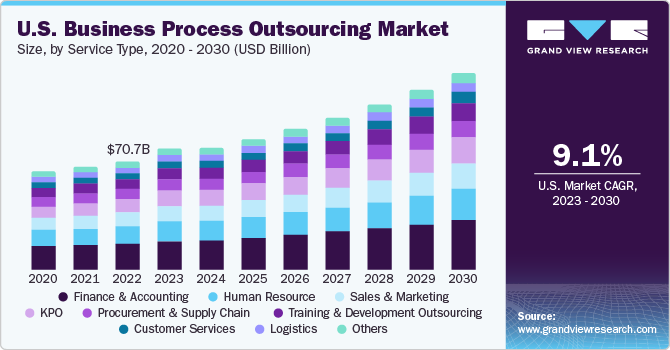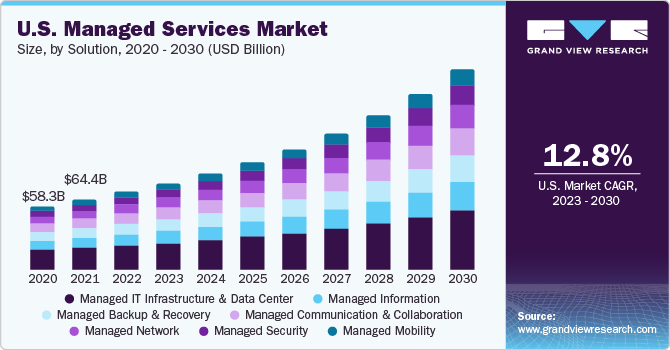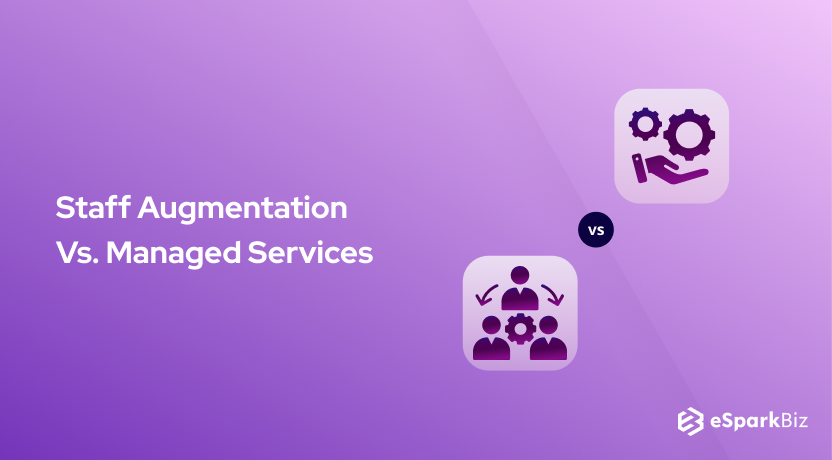For a company to run successfully, it has to look at cost-cutting. Not just the ones who have entered the market recently, but even the Fortune 500 ones. 2024 is the year of cost cuts, where companies like Nike, PayPal, and Cisco did massive layoffs.
But does this mean that the companies are cutting out on the operations aspect of the business?

No, instead, they outsource. They get people to work for them externally for a certain period of time. The whole outsourcing market is expected to reach $525 billion by 2030. That means more businesses will outsource.
However, one major problem that comes with outsourcing is finding the perfect balance between operations and resources. When a company decides to outsource certain tasks or operations to an external IT partner, it’s crucial to choose the right partner.
If the chosen partner is suitable and capable, the company should have the necessary resources and support to manage the outsourced tasks efficiently. The success of outsourcing depends on selecting a competent partner who can provide the required resources and expertise.
Here’s where staff augmentation and managed services come into the picture. Both solutions help businesses with outsourcing and hiring, especially in the IT domain.

But what’s the difference between managed services and staff augmentation? Let’s dive into each:
Understanding Staff Augmentation vs. Managed Services
What is Staff Augmentation?
Staff augmentation is simply outsourcing employees for projects. The organisation must be clear about its current staffing needs and objectives.
For example, if the company wishes to launch a messaging app and requires 10 developers for the same, only 4 are available in-house, and the need for more than 6 members is there. Over here, if the company starts with the hiring procedure, it will probably take a month or more. If the deadline is near, the project launch will be delayed, and revenue will be hampered.
By leveraging the IT staff augmentation services, the same company can hire 6 more developers, complete the product, and launch it on the d-day. The whole augmenting staff process involves outsourcing. So once the project gets completed, there’s no need to fire the employees.
Any business can augment staff for just a week, a month, or even a year. The augmentation solves the issue at hand quickly. It brings in benefits, and the in-house employees don’t get stressed or overstretched.
What is Managed Services?
In managed services, businesses can either fully or partially outsource the different parts of the business. For example, migration, implementation, or maintenance (including backup or security). The third-party vendor does this job remotely or from an offshore location.
Usually, the solutions outsourced here are managed IT services, and the solution provider is called a managed services provider (MSP).
If an agreement is signed, the MSP offers continuous IT Outsourcing services and is paid monthly or weekly. A reliable MSP gives much attention to your business; hence, the micromanagement process goes out. But if you choose an incorrect supplier, you might need help.
Staff Augmentation Vs Managed Services : Key Types & Facts
Types of Staff Augmentation
Apart from hiring individuals temporarily, there are many other types of staff augmentation, like:
- Temporary Staffing: Providing temporary employees to fill short-term roles or to handle workload spikes.
- Contract Staffing: Supplying skilled professionals on a contract basis for specific projects or periods.
- Project-based Staffing: Offering resources specifically for project-based requirements ensures teams have the necessary skills for successful project completion.
- Skill-specific Staffing: Providing individuals with specialized skills or expertise to complement existing teams.
- Onshore, Nearshore, and Offshore Staffing: Offering resources locally (onshore), in nearby countries (nearshore), or in different regions (offshore) to leverage cost advantages and access to specific talent pools.
Also Read: Nearshore vs. In-house Software Development
Types of Managed Services
Other than outsourcing cloud-based services, there are a lot of other types of managed services; some popular ones are:
- IT Infrastructure Management: Outsourcing the management and maintenance of IT infrastructure components such as servers, networks, and storage.
- Cloud Services: Managing multi cloud infrastructure, including migration, deployment, monitoring, and optimization.
- Security Services: Providing cybersecurity solutions, including threat detection, prevention of data theft, and incident response.
- Application Management: Handling the operation, support, and maintenance of software applications throughout their lifecycle.
- Data Management: Managing data storage, processing, and analytics, ensuring data integrity, availability, and security.
- Help Desk and Support Services: Offering technical support, troubleshooting, and assistance to end-users.
- Managed Print Services: Outsourcing the management of printing devices and related services, including maintenance and supplies.
Also Read : IT Staff Augmentation vs Managed Services
Advantages of Staff Augmentation
There are numerous benefits of staff augmentation model that is boosting business growth. Let’s understand each with examples:
Flexibility and scalability
Businesses, with staff augmentation, can scale their teams according to what the project demands. For example, if you want to temporarily expand your team, get a project, or maybe ramp down during quiet business quarters,. Staff augmentation allows you to adjust your resources.
With this flexibility, businesses can have the right talent in place whenever they need it. There’s no long-term commitment they have to fulfill or any overhead cost of hiring.
Let’s say there’s a Custom software development company that wants to augment its team with additional developers. They can bring in skilled contractors temporarily, scale up their workforce, and then scale down once the project is completed.
Access to specialized talent
One of the major advantages of staff augmentation is you get top talent in their employee pool. Whether there’s a need for someone aware of a specific programming language, technology stack, or industry domain, you can bring them. This is particularly beneficial for businesses that want expertise beyond their internal team’s capabilities.
For example, there’s a marketing agency that needs a data scientist to analyze large datasets. They won’t have one on their team right now. However, they can augment one without having to invest in hiring and training new employees.
Cost-effective
With staff augmentation, companies don’t hire employees full-time; it’s done simply for short-term project needs. They only have to pay for the resources they use, maybe hourly, daily, or monthly. This will help with cost savings.
If done, a quick cost comparison with staff augmentation vs. managed services shows that staff augmentation allows businesses to skip the benefits of providing parts like healthcare, retirement plans, paid time off, and more. For example, a startup wants to launch a mobile app. They augment staff who are skilled app developers on a contract basis, hence saving on both
Speedy delivery
Staff augmentation helps businesses speed up their delivery. Instead of waiting to hire and onboard new employees, they can quickly augment their existing teams to meet project deadlines. This specific agility is best in fast-paced industries.
For example, a pharmaceutical company is developing a new drug. They augment the research and development team with specialized scientists and expedite the drug delivery process – hence, they can stay ahead of their competitors.
Reduced risk and liability
Staff augmentation allows businesses to avoid long-term commitments. This is helpful as companies can scale their teams up or down as needed without the financial and legal implications. There’s always fluctuating demand in the market; that’s why the risk of layoffs and termination is not there when they increase.
In addition to this, by outsourcing specific tasks and projects to external contractors, businesses can transfer their risks. They can get rid of compliance and performance issues. For example, a financial services firm may choose to augment its compliance team with external consultants. By this action, both regulatory requirements are met without the firm taking the whole burden of compliance on the management.
Advantages of Managed Services
Similar to staff augmentation, even managed services offer many benefits to businesses. Some major ones are:
More Focus on Core Business Activities
Companies usually outsource non-core functions to specialized service providers. Hence, this solution allows them to focus on their core competencies. They can offload their routine or time-consuming tasks like IT infrastructure management, customer support, or cybersecurity to MSPs.
This focus on core business can increase efficiency and productivity. For example, a manufacturing company may partner with an MSP to manage its IT infrastructure. This will allow the manufacturer to focus on developing new products and improving their manufacturing process.
Access to Expertise
Managed services give businesses access to expertise. They might be lacking some best practices or industry standards internally. But MSPs have that specialized knowledge and experience. That’s why they are better able to deliver high-quality services and solutions, both efficiently and effectively.
If the company can leverage the expertise of MSPd, they can benefit from the latest tools, methods, and technology. They will not have to invest in training or hiring additional staff. This will help them improve their operational performance and their overall business outcomes.
Let’s say there’s a retail company that gets an MSP to manage its e-commerce platform. With the MSP’s expertise, they can optimize their website’s performance and security aspects.
Cost Predictability and Control
Managed services help with cost control and predictability. A company can get an MSP at a fixed monthly pricing or an annual subscription. So no incurring unpredictable expenses is happening throughout.
For example, a business can budget more effectively with a flat rate fee from a provider. This predictable cost structure will help them improve financial planning, forecasting, and budget allocation.
Additionally, if the company outsources non-core functions to MSPs, it can achieve cost savings. How? They can leverage economies of scale and the operational efficiencies of the service provider.
Let’s say, a healthcare provider is partnering with an MSP for managed services. They predicted a monthly fee for network monitoring, maintenance, and support. Hence, there was no need to further investigate expensive networking equipment or dedicated IT staff in the future.
Scalability
Business needs and growth requirements keep on changing. Maybe a business will need to scale its IT infrastructure to support business expansion. Or there is fluctuating demand happening around the year and they want to adjust the service levels. MSPs quickly adapt to these changing needs.
The business, therefore, doesn’t have to take up the expense of procuring and deploying additional resources internally. For example, there is a hospitality company that is engaged with an MSP for managed cloud services. The MSP was able to scale the computing resources up or down based on occupancy levels and peak booking periods. That’s why the hospitality company was not over-provisioning or underutilizing its IT resources.
Proactive Monitoring and Maintenance
Lastly, the main difference between managed services and staff augmentation is, the first one helps businesses monitor issues before they occur and minimise downtime. Managed service providers use advanced monitoring tools and techniques to check out performance continuously. They can quickly identify and address potential issues in real-time to ensure better performance and reliability.
When the company outsources routine maintenance tasks like software updates, patches, and backups to MSP, it can ensure that its environment remains secure and up to date. For example, a financial institution partners with an MSP for managed cyber security services. In return, they get updates 24/7 and their customer data stays safe against cyber threats.
IT Staff Augmentation Vs. Managed Services : Best Practices for Successful Implementation
How do you successfully implement staff augmentation?
The major difference between staff augmentation vs managed services is seamlessly integrating external talent into the existing workforce. The mission here is to maximise value and minimise risks, and for that, one should:
Define clear objectives
An organisation must make sure that project objectives are clearly defined. Along with it, the desired outcomes and the specific roles and responsibilities must be discussed. This ensures alignment between the external resources and the project goals, setting the stage for success.
Thoroughly Vet and Select Providers
Take the time to thoroughly vet potential staff augmentation providers. Always assess their expertise, track record, and cultural fit with your organisation. Look for providers with a proven history of delivering quality talent and supporting successful projects in your industry.
Monitor Performance and Provide Feedback
Regularly monitor the performance of augmented staff and provide timely feedback. Initially try establishing key performance indicators (KPIs). This will help you to measure progress and ensure that performance expectations are clearly communicated and understood.
Collaborate and Share Knowledge
Both the internal and augmented staff must collaborate. This will further help them to leverage diverse perspectives and expertise while working on a single project.
Regularly Evaluate and Adjust Strategies
Continuously check out the effectiveness of staff augmentation strategies you have made. Try making adjustments as needed to address challenges and capitalise on opportunities for improvement. Also, solicit feedback from both internal and augmented staff to identify areas for optimization.
How to successfully implement managed services?
Similar to staff augmentation, even implementing managed services requires careful planning and execution. The motive here is also the same, minimising risks and maximising value, which can be achieved by:
Defining Clear Service Level Agreements (SLAs)
Always define service level agreements (SLAs). The agreement must include the scope of services, performance metrics, and responsibilities of both parties. Clear expectations must be shared, starting from service quality and response time to escalation procedures, before getting into the agreement.
Select the Right Service Provider
Again, choose a managed services provider (MSP) that has a proven track record, industry expertise, and a strong commitment to offering value. For this, you will have to conduct thorough due diligence.
Regularly Monitor Performance and Service Quality
To track the effectiveness of managed services, make sure to implement proper monitoring and performance management processes. This will help you understand whether service levels are consistently met or exceeded. Regularly review performance metrics, analyse trends, and address any deviations from agreed-upon standards.
Provide Adequate Training and Support (to internal stakeholders)
Always offer internal stakeholders adequate training and support to effectively interact with the managed services provider. This will maximise the value of the services delivered. You can either offer ongoing education or some training programs to build internal expertise and promote collaboration.
Stay Agile and Responsive to Change
Maintain agility and flexibility in managing managed services. This will help you adapt to changing business needs, market conditions, and technological advancements. Try regularly reviewing and updating service offerings, processes, and procedures to stay aligned with evolving requirements.
IT Managed Services vs. Staff Augmentation: What to choose?
Now here comes the main part. Which outsourcing model will be the best one? For this, you will first have to assess your business needs. Check out the pros and cons that go with opting for each model.
Both models offer unique solutions, and we have mentioned each with an example above. The decision a business will take should depend on software development time, level of control, and business requirements.
To help businesses better with decision making, here is a quick table covering all the difference between staff augmentation and managed services, advantages, and more:
| Staff Augmentation | Managed Services | |
| Demand | Often utilised for short term projects, filling a specific skill gap in an organisation. | Utilised for ongoing, long-term support and management of some specific process or function of an organisation. |
| Advantages |
|
|
| Disadvantages |
|
|
| Applications | Software development projects, IT infrastructure upgrades | Cloud management, cybersecurity operations |
| Security | Organisations have to look after the security measures. They must ensure that the augmented staff adhere to the policies and protocols. | MSPs look after prioritising security of their security offerings, company’s can stay rest assured. |
| Agreements and legalities | Organisations have to sign a contract with the individual contractors or staffing agencies. The agreements cover all the terms and conditions, rates, roles and responsibilities, and work scope. | A more comprehensive contract has to be signed here between the organisation and MSP. The agreement must cover work scope, service levels, pricing, and terms of engagement. |
Conclusion
There’s a major difference between both IT outsourcing models . Staff Augmentation involves hiring temporary resources to fill specific skill gaps or augment existing teams Managed services entail outsourcing the management and responsibility of certain functions or processes to a third-party provider.
The advantage of augmentation lies in its flexibility and scalability. It allows businesses to quickly ramp up or down their resources according to project needs without the long-term commitments associated with traditional hiring. However, it can sometimes result in integration challenges and require significant oversight from the business.
On the other hand, managed services provide a more comprehensive and hands-off approach to outsourcing. By entrusting the management of certain functions to a specialized provider, businesses can focus on their core competencies and strategic initiatives. However, this model often involves longer-term contracts and may not offer the same level of control or customization as compared to augmenting.
As a business, you must be aware of your needs, project requirements, and objectives. For short-term projects requiring specialised skills, staff augmentation may be the ideal choice. Conversely, for ongoing operations or strategic initiatives, managed services could offer more value and stability.
So, are you ready to choose just the one that best suits your needs?







